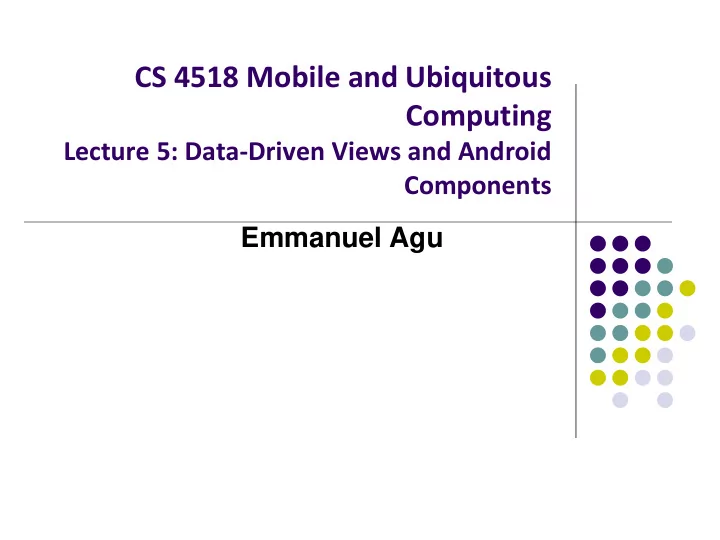

CS 4518 Mobile and Ubiquitous Computing Lecture 5: Data-Driven Views and Android Components Emmanuel Agu
Announcements Slight modifications to course timeline posted No class February 16 (Advising day) Class on March 2 and 3, 2017 Today is deadline to form groups for final project Projects 2 & 3 will also be done in these groups Final projects from teams D term 2016 are also posted http://web.cs.wpi.edu/~emmanuel/courses/cs403x/D16/projects/final_project/final_project.html
Data-Driven Layouts
Data-Driven Layouts LinearLayout, RelativeLayout, TableLayout, GridLayout useful for positioning UI elements Data is literally hard coded Other layouts dynamically composed from data ListView, GridView, GalleryView Tabs with TabHost, TabControl
Data Driven Layouts May want to populate views from a data source (XML file or database) Layouts that display repetitive child Views from data ListView GridView GalleryView ListView vertical scroll, horizontal row entries, pick item
Data Driven Containers GalleryView GridView List with horizontal scrolling, List with specified number of rows and typically images columns
AdapterView ListView, GridView, and GalleryView are sub classes of AdapterView (variants) Adapter: generates widgets from a data source, populates layout E.g. Data is adapted into cells of GridView Data lorem ipsum dolor amet consectetuer Adapter adipiscing elit morbi Most common Adapters CursorAdapter: read from database ArrayAdapter: read from resource (e.g. XML file)
Adapters When using Adapter, a layout (XML format) is defined for each child element (View) The adapter Reads in data (list of items) Creates Views (widgets) using layout for each element in data source Fills the containing layout (List, Grid, Gallery) with the created Views Child Views can be as simple as a TextView or more complex layouts / controls simple views can be declared in android.R.layout
Example: Creating ListView using AdapterArray Task: Create listView (on right) from strings below Enumerated list ListView of items
Example: Creating ListView using AdapterArray First create Layout file (e.g. LinearLayout) TextView Widget for selected list item Widget for main list of activity
Using ArrayAdapter Command used to wrap adapter around array of menu items or java.util.List instance Context to use. (e.g app’s activity) Resource ID of Array of items View for formatting to display E.g. android.R.layout.simple_list_item_1 turns strings into textView objects
Example: Creating ListView using AdapterArray Set list adapter (Bridge Data source and views) Get handle to TextView of Selected item Change Text at top to that of selected view when user clicks on selection
Android App Components
Android App Components Typical Java program starts from main( ) Android app: No need to write a main Just define app components derived from base classes already defined in Android 4 main types of Android app components: Activities (already seen this) Services Content providers Broadcast receivers
Recall: Activities Activity: main building block of Android UI Analogous to a window or dialog box in a desktop application Apps have at least 1 activity that deals with UI Entry point of app similar to main( ) in C typically have multiple activities Example: A camera app Activity 1: to focus, take photo, start activity 2 Activity 2: to present photo for viewing, save it
Fragments Fragments Enables app to look different on different devices (e.g. phone vs tablet) UI building blocks that can be attached to Activities in different ways. An activity can contain multiple fragments that are organized differently for phone vs tablet More later
Services Activities are short-lived, can be shut down anytime (e.g when user presses back button) Services keep running in background Similar to Linux/Unix CRON job Example uses of services: Periodically check device’s GPS location Check for updates to RSS feed Minimal interaction with (independent of) any activity Typically an activity will control a service -- start it, pause it, get data from it App Services are sub-class of Services class
Android Platform Services Android Services can either be on: Android Platform (local, on smartphone) Google (remote, in Google server) Android platform services examples (on smartphone): LocationManager: location-based services. ClipboardManager: access to device’s clipboard, for cutting and pasting content. DownloadManager: manages HTTP downloads in background FragmentManager: manages the fragments of an activity. AudioManager: provides access to audio and ringer controls.
Google Services (In Google Cloud) Maps Location-based services Game Services Authorization APIs Google Plus Play Services Typically need Internet In-app Billing connection Google Cloud Messaging Google Analytics Google AdMob ads
Content Providers Android apps can share data (e.g. User’s contacts) as content provider Content Provider: Abstracts shareable data, makes it accessible through methods Applications can access that shared data by calling methods for the relevant content provider E.g. Can query, insert, update, delete shared data (see below) Shared data
Content Providers Example: We can write an app that: Retrieve’s contacts list from contacts content provider Adds contacts to social networking (e.g. Facebook) Apps can also ADD to data through content provider. E.g. Add contact E.g. Our app can also share its data App Content Providers are sub-class of ContentProvider class
Broadcast Receivers The system, or applications, periodically broadcasts events Example broadcasts: Battery getting low Download completed New email arrived Any app can create broadcast receiver to listen for broadcasts, respond Our app can also initiate broadcasts Broadcast receivers Typically don't interact with the UI Commonly create a status bar notification to alert the user when broadcast event occurs App Broadcast Receivers are sub-class of BroadcastReceiver class
Quiz Pedometer App Component A: continously counts user’s steps even when user closes app, does other things on phone (e.g. youtube, calls) Component B: Displays user’s step count Component C: texts user’s friends every day with their step totals What should component A be declared as (Activity, service, content provider, broadcast receiver) What of component B? Component C?
References Busy Coder’s guide to Android version 4.4 CS 65/165 slides, Dartmouth College, Spring 2014 CS 371M slides, U of Texas Austin, Spring 2014
Recommend
More recommend